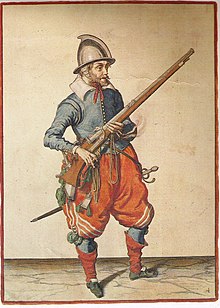java
JavaScript (/ˈdʒævəˌskrɪpt/) is a high-level, dynamic, untyped, and interpreted programming language. It has been standardized in the ECMAScript language specification.
Sunday, 22 January 2017
Wednesday, 4 January 2017
Tuesday, 3 January 2017
Monday, 2 January 2017
Knowledge
Knowledge come for learning
Wisdom come for living
History of gun
Further information: History of the firearm
Hand cannon from the Chinese Yuan Dynasty (1271-1368)
Western European handgun, 1380
Depiction of a musketeer (1608)
An early type of firearm (or portable gun) is the fire lance, a black-powder–filled tube attached to the end of a spear and used as a flamethrower; shrapnel was sometimes placed in the barrel so that it would fly out together with the flames.[6][7] The earliest depiction of a gunpowder weapon is the illustration of a fire-lance on a mid-10th century silk banner from Dunhuang.[8] The De'an Shoucheng Lu, an account of the siege of De'an in 1132, records that Song forces used fire-lances against the Jurchens.[9]
In due course, the proportion of saltpeter in the propellant was increased to maximise its explosive power.[7] To better withstand that explosive power, the paper and bamboo of which fire-lance barrels were originally made came to be replaced by metal.[6] And to take full advantage of that power, the shrapnel came to be replaced by projectiles whose size and shape filled the barrel more closely.[7] With this, we have the three basic features of the gun: a barrel made of metal, high-nitrate gunpowder, and a projectile which totally occludes the muzzle so that the powder charge exerts its full potential in propellant effect.[10]
One theory of how gunpowder came to Europe is that it made its way along the Silk Road through the Middle East; another is that it was brought to Europe during the Mongol invasion in the first half of the 13th century.[11][12] English Privy Wardrobe accounts list "ribaldis", a type of cannon, in the 1340s, and siege guns were used by the English at Calais in 1346.[13] The earliest surviving[clarification needed] firearm in Europe has been found from Otepää, Estonia and it dates to at least 1396.[14]
Around the late 14th century in Europe, smaller and portable hand-held cannons were developed, creating in effect the first smooth-bore personal firearm. In the late 15th century the Ottoman empire used firearms as part of its regular infantry.
The first successful rapid-fire firearm is the Gatling Gun, invented by Richard Gatling and fielded by the Union forces during the American Civil War in the 1860s.
The world's first sub-machine gun (a fully automatic firearm which fires pistol cartridges) able to be maneuvered by a single soldier is the MP18.1, invented by Theodor Bergmann. It was introduced into service in 1918 by the German Army during World War I as the primary weapon of the Stosstruppen (assault groups specialized in trench combat).
The first assault rifle was introduced during World War II by the Germans, known as the StG44. It was the first firearm which bridges the gap between long range rifles, machine guns, and short range sub-machine guns. Since the mid-20th century guns that fire beams of energy rather than solid projectiles have been developed, and also guns that can be fired by means other than the use of gunpowder.
Operating principle
Most guns use compressed gas confined by the barrel to propel the bullet up to high speed, though devices operating in other ways are sometimes called guns. In firearms the high-pressure gas is generated by combustion, usually of gunpowder. This principle is similar to that of internal combustion engines, except that the bullet leaves the barrel, while the piston transfers its motion to other parts and returns down the cylinder. As in an internal combustion engine, the combustion propagates by deflagration rather than by detonation, and the optimal gunpowder, like the optimal motor fuel, is resistant to detonation. This is because much of the energy generated in detonation is in the form of a shock wave, which can propagate from the gas to the solid structure and heat or damage the structure, rather than staying as heat to propel the piston or bullet. The shock wave at such high temperature and pressure is much faster than that of any bullet, and would leave the gun as sound either through the barrel or the bullet itself rather than contributing to the bullet's velocity.
Subscribe to:
Comments
(
Atom
)


